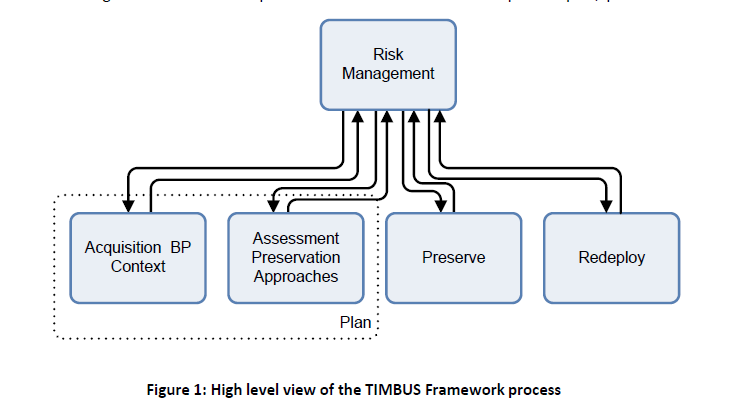Timbus on Twitter
TIMBUS Partners










- Details
- Last Updated on Thursday, 30 October 2014 11:12
Vision
The EU co-funded TIMBUS project focuses on resilient business processes. It will make the execution context, within which data is processed, analysed, transformed and rendered, accessible over long periods. Furthermore, continued accessibility is often considered as a set of activities carried out in the isolation of a single domain. TIMBUS, however, considers the dependencies on third-party services, information and capabilities that will be necessary to validate digital information in a future usage context.
TIMBUS will deliver activities, processes and tools that ensure
- continued access to services and software
- to produce the context within which information can be accessed, properly rendered, validated and transformed into knowledge.
This approach extends traditional digital preservation approaches by introducing the need to analyse and sustain accessibility to business processes and the supporting services, and it aligns preservation actions more fully with enterprise risk management (ERM) and business continuity management (BCM). The complexity and scale of enterprise business processes makes TIMBUS exceptionally relevant.
- Details
- Last Updated on Thursday, 18 December 2014 13:49
 TIMBUS digitally captures and preserves business processes by extracting and analysing the entire environment around the activities and interactions of an organisation's daily work. In order to successfully preserve these abstract processes, TIMBUS must model the context of a business, both at a conceptual level and at the instance level. In order to achieve this, The TIMBUS Context Model provides a means of modelling context and dependencies so that all the information required for preserving and redeploying a process is captured. This White Paper, 'Federating real world information about business processes into the TIMBUS Context Model' by Till Riedel gives a high-level overview of how 'linked data structures can be used to federate relevant manually modelled and automatically extracted information into a single consolidated model'.
TIMBUS digitally captures and preserves business processes by extracting and analysing the entire environment around the activities and interactions of an organisation's daily work. In order to successfully preserve these abstract processes, TIMBUS must model the context of a business, both at a conceptual level and at the instance level. In order to achieve this, The TIMBUS Context Model provides a means of modelling context and dependencies so that all the information required for preserving and redeploying a process is captured. This White Paper, 'Federating real world information about business processes into the TIMBUS Context Model' by Till Riedel gives a high-level overview of how 'linked data structures can be used to federate relevant manually modelled and automatically extracted information into a single consolidated model'.
- Details
- Last Updated on Thursday, 18 December 2014 13:50
 How can we preserve dynamic workflows and activities, rather than just static data? In this White Paper on TIMBUS Process, Stephan Strodl from SBA details the methods and framework developed in TIMBUS to digitally preserve business processes. The framework is domain independent and describes the information flow between the steps of the TIMBUS preservation process, provides recommendations for suitable methods and tools for performing preservation, and defines responsibilities and roles of stakeholders involved in the different preservation steps.
How can we preserve dynamic workflows and activities, rather than just static data? In this White Paper on TIMBUS Process, Stephan Strodl from SBA details the methods and framework developed in TIMBUS to digitally preserve business processes. The framework is domain independent and describes the information flow between the steps of the TIMBUS preservation process, provides recommendations for suitable methods and tools for performing preservation, and defines responsibilities and roles of stakeholders involved in the different preservation steps.
TIMBUS Process by Stephan Strodl
- Details
- Last Updated on Thursday, 18 December 2014 13:48

This White Paper on A Risk Management Approach to Preservation of Business Processes by Ricardo Vieira explores the application of risk assessment to the digital preservation of business processes. Though the relationship between risk management and digital preservation has been established in earlier studies, the unique requirements of TIMBUS - of preserving an entire business context - brings an entirely new application of risk management to digital preservation. This paper introduces a generic risk management process to assess and mitigate risks to business processes using digital preservation techniques and describes a tool developed in TIMBUS that can support this process.
A Risk Management Approach to Preservation of Business Processes by Ricardo Vieira
- Details
- Last Updated on Thursday, 18 December 2014 13:48
This White Paper by Tomasz Miksa on Verification and Validation discusses the VFramework, an integral part of the TIMBUS approach. The paper explains how the VFramework offers a solution for intercepting the interactions of processes with external influencers in order to verify that the collected data is sufficient for the purpose of redeployment and the redeployed process performs according to expectations.

